A Low Profile Ultra-Wideband Antenna with Reconfigurable Notch Band Characteristics for Smart Electronic Systems
Abstract
1. Introduction
2. Antenna Designing
2.1. UWB Antenna Design
2.2. UWB Antenna with WLAN Notch Band
2.3. UWB Antenna with 5G Sub-6 GHz Notch Band
2.4. UWB Antenna with Reconfigurable Dual Notch Band
2.5. Optimization Algorithm
3. Results and Discussion
3.1. Simulation and Measurments Setup
3.2. VSWR
3.3. Radiation Pattern
3.4. Surface Current Distribution
3.5. Gain and Efficiency
4. Comparison with the Related Works in the Literature
5. Conclusions
Author Contributions
Funding
Institutional Review Board Statement
Informed Consent Statement
Data Availability Statement
Acknowledgments
Conflicts of Interest
References
- FCC. FCC 1st Report and Order on Ultra-Wideband Technology; FCC: Washington, DC, USA, 2002.
- Naqvi, S.A. Miniaturized triple-band and ultra-wideband (UWB) fractal antennas for UWB applications. Microw. Opt. Technol. Lett. 2017, 59, 1542–1546. [Google Scholar] [CrossRef]
- Singhal, S.; Singh, A.K. Flower-shaped ultra-wideband fractal antenna. Int. J. RF Microw. Comput.-Aid. Eng. 2019, 29, e21885. [Google Scholar] [CrossRef]
- Tiwari, R.N.; Singh, P.; Kanaujia, B.K.; Srivastava, K. Neutralization technique based two and four port high isolation MIMO antennas for UWB communication. AEU—Int. J. Electron. Commun. 2019, 110, 152828. [Google Scholar] [CrossRef]
- Guo, L.; Min, M.; Che, W.; Yang, W. A novel miniaturized planar Ultra-Wideband antenna. IEEE Access 2018, 7, 2769–2773. [Google Scholar] [CrossRef]
- Hussain, N.; Jeong, M.; Park, J.; Rhee, S.; Kim, P.; Kim, N. A compact size 2.9–23.5 GHz microstrip patch antenna with WLAN band-rejection. Microw. Opt. Technol. Lett. 2019, 61, 1307–1313. [Google Scholar] [CrossRef]
- Awan, W.A.; Zaidi, A.; Hussain, N.; Iqbal, A.; Baghdad, A. Stub loaded, low profile UWB antenna with independently controllable notch-bands. Microw. Opt. Technol. Lett. 2019, 61, 1–8. [Google Scholar] [CrossRef]
- Li, Y.; Li, W.; Ye, Q. A CPW-fed circular wide-slot UWB antenna with dual-notch bands by combining slot and parasitic element techniques. Microw. Opt. Technol. Lett. 2014, 56, 1240–1244. [Google Scholar] [CrossRef]
- Li, Y.; Li, W.; Yu, W. A CPW-fed circular slot UWB antenna with WLAN band and X-band filtering characteristics using hybrid resonators. Microw. Opt. Technol. Lett. 2014, 56, 925–929. [Google Scholar] [CrossRef]
- Li, Y.; Li, W.; Ye, Q. A compact UWB antenna with dual band-notch characteristics using nested split ring resonator and stepped impedance resonator. Microw. Opt. Technol. Lett. 2013, 55, 2827–2830. [Google Scholar] [CrossRef]
- Puri, S.C.; Das, S.; Gopal-Tiary, M. An UWB trapezoidal rings fractal monopole antenna with dual-notch characteristics. Int. J. RF Microw. Comput.-Aid. Eng. 2019, 29, 21777. [Google Scholar] [CrossRef]
- Sanyal, R.; Sarkar, P.P.; Sarkar, S. Octagonal nut shaped monopole UWB antenna with sextuple band notched characteristics. AEU—Int. J. Electron. Commun. 2019, 110, 152833. [Google Scholar] [CrossRef]
- Khan, M.S.; Capobianco, A.D.; Naqvi, A.; Shafique, M.F.; Ijaz, B.; Braaten, B.D. Compact planar UWB MIMO antenna with on-demand WLAN rejection. Electron. Lett. 2015, 51, 963–964. [Google Scholar] [CrossRef]
- Lakrit, S.; Das, S.; El-Alami, A.; Barad, D.; Mohapatra, S. A compact UWB monopole patch antenna with reconfigurable Band-notched characteristics for Wi-MAX and WLAN applications. AEU—Int. J. Electron. Commun. 2019, 105, 106–115. [Google Scholar] [CrossRef]
- Rahman, S.U.; Cao, Q.; Li, Y.; Gil, I.; Yi, W. Design of tri-notched UWB antenna based on elliptical and circular ring resonators. Int. J. RF Microw. Comput.-Aid. Eng. 2019, 29, 21648. [Google Scholar] [CrossRef]
- Li, Y.; Li, W.; Ye, Q. A compact circular slot UWB antenna with multimode reconfigurable band-notched characteristics using resonator and switch techniques. Microw. Opt. Technol. Lett. 2014, 56, 570–574. [Google Scholar] [CrossRef]
- Li, Y.; Li, W.; Mittra, R. A CPW-fed wide-slot antenna with reconfigurable notch bands for UWB and multi-band communication applications. Microw. Opt. Technol. Lett. 2013, 55, 2777–2782. [Google Scholar] [CrossRef]
- Nazeri, A.H.; Falahati, A.; Edwards, R.M. A novel compact fractal UWB antenna with triple reconfigurable notch reject bands applications. AEU—Int. J. Electron. Commun. 2019, 101, 1–8. [Google Scholar] [CrossRef]
- Al-Bawri, S.S.; Goh, H.H.; Islam, M.S.; Wong, H.Y.; Jamlos, M.F.; Narbudowicz, A.; Jusoh, M.; Sabapathy, T.; Khan, R.; Islam, M.T. Compact Ultra-Wideband Monopole Antenna Loaded with Metamaterial. Sensors 2020, 20, 796. [Google Scholar] [CrossRef]
- Balanis, C.A. Antenna Theory Analysis and Design, 4th ed.; Wiley: New York, NY, USA, 2016. [Google Scholar]
- Martínez-Lozano, A.; Blanco-Angulo, C.; García-Martínez, H.; Gutiérrez-Mazón, R.; Torregrosa-Penalva, G.; Ávila-Navarro, E.; Sabater-Navarro, J.M. UWB-printed rectangular-based monopole antenna for biological tissue analysis. Electronics 2021, 10, 304. [Google Scholar] [CrossRef]
- Ramanujam, P.; Venkatesan, P.R.; Arumugam, C.; Ponnusamy, M. Design of miniaturized super wideband printed monopole antenna operating from 0.7 to 18.5 GHz. AEU—Int. J. Electron. Commun. 2020, 123, 153273. [Google Scholar] [CrossRef]
- Zaidi, A.; Ali, E.M.; Alharbi, A.G.; Khan, S.U.; Alsharef, M.; Alzaidi, M.S.; Ghoneim, S.S.M. Multi-mode frequency reconfigurable conformal antenna for modern electronic systems. Comput. Mater. Contin. 2022, 73, 3861–3877. [Google Scholar] [CrossRef]
- Malik, J.; Patnaik, A.; Kartikeyan, M. Compact Antennas for High Data Rate Communication; Springer: Cham, Switzerland, 2018. [Google Scholar]
- Awan, W.A.; Zaidi, A.; Hussain, M.; Hussain, N.; Syed, I. The design of a wideband antenna with notching characteristics for small devices using a genetic algorithm. Mathematics 2021, 9, 2113. [Google Scholar] [CrossRef]
- Labiod, M.; Mahdjoub, Z.; Debab, M. Frequency reconfigurable circular microstrip patch antenna with slots for cognitive radio. TELKOMNIKA (Telecommun. Comput. Electron. Control) 2022, 20, 740–752. [Google Scholar] [CrossRef]
- Ghaffar, A.; Li, X.J.; Awan, W.A.; Hussain, N. Reconfigurable Antenna: Analysis and Applications; Wideband, Multiband, and Smart Antenna Systems; Springer: Cham, Switzerland, 2021; pp. 269–323. [Google Scholar]
- Skyworks Solutions. Available online: https://www.skyworksinc.com (accessed on 20 May 2022).
- Iqbal, A.; Smida, A.; Mallat, N.K.; Ghayoula, R.; Elfergani, I.; Rodriguez, J.; Kim, S. Frequency and pattern reconfigurable antenna for emerging wireless communication systems. Electronics 2019, 8, 407. [Google Scholar] [CrossRef]
- Panagiotou, S.C.; Thomopoulos, S.C.A.; Capsalis, C.N. Genetic algorithms in antennas and smart antennas design overview: Two novel antenna systems for triband GNSS applications and a circular switched parasitic array for WiMAX applications developments with the use of genetic algorithms. Int. J. Antennas Propag. 2014, 2014, 729208. [Google Scholar] [CrossRef]
- Haupt, R.L. An introduction to genetic algorithms for electromagnetics. IEEE Antennas Propag. Mag. 1995, 37, 7–15. [Google Scholar] [CrossRef]
- Ansoft, L. An Introduction to HFSS Fundamental Principles, Concepts, and Use; Ansoft: Pittsburgh, PA, USA, 2009. [Google Scholar]
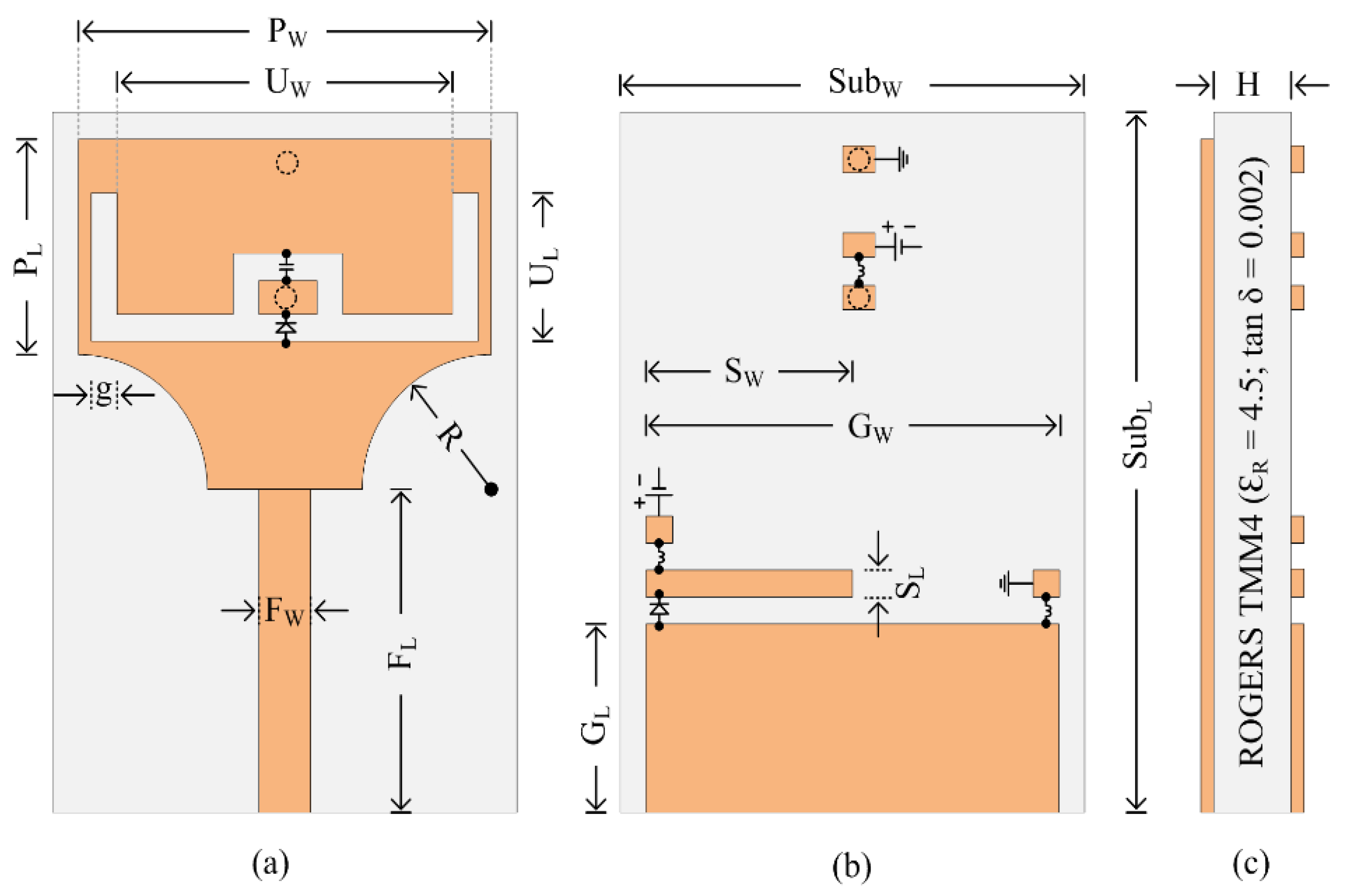
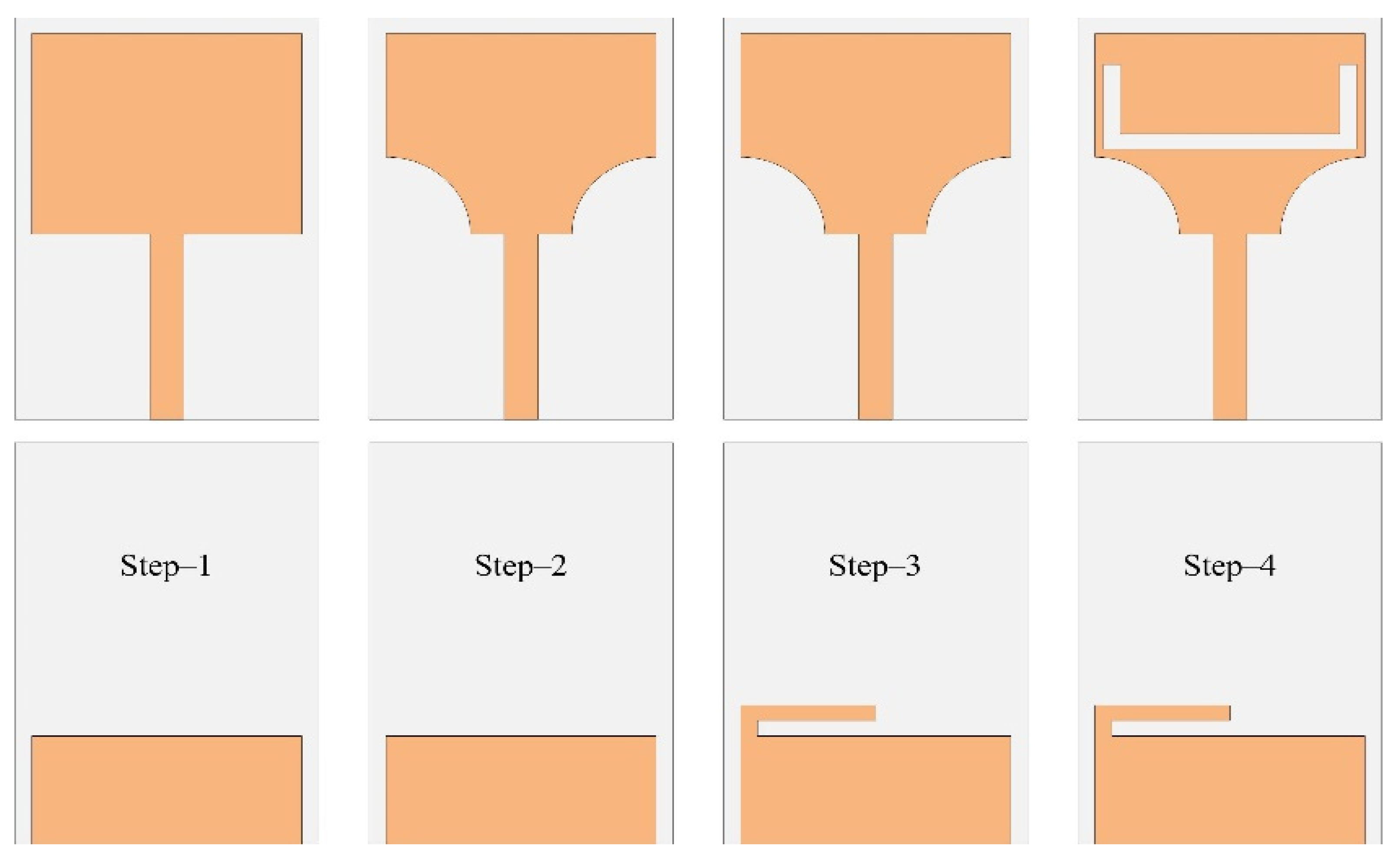
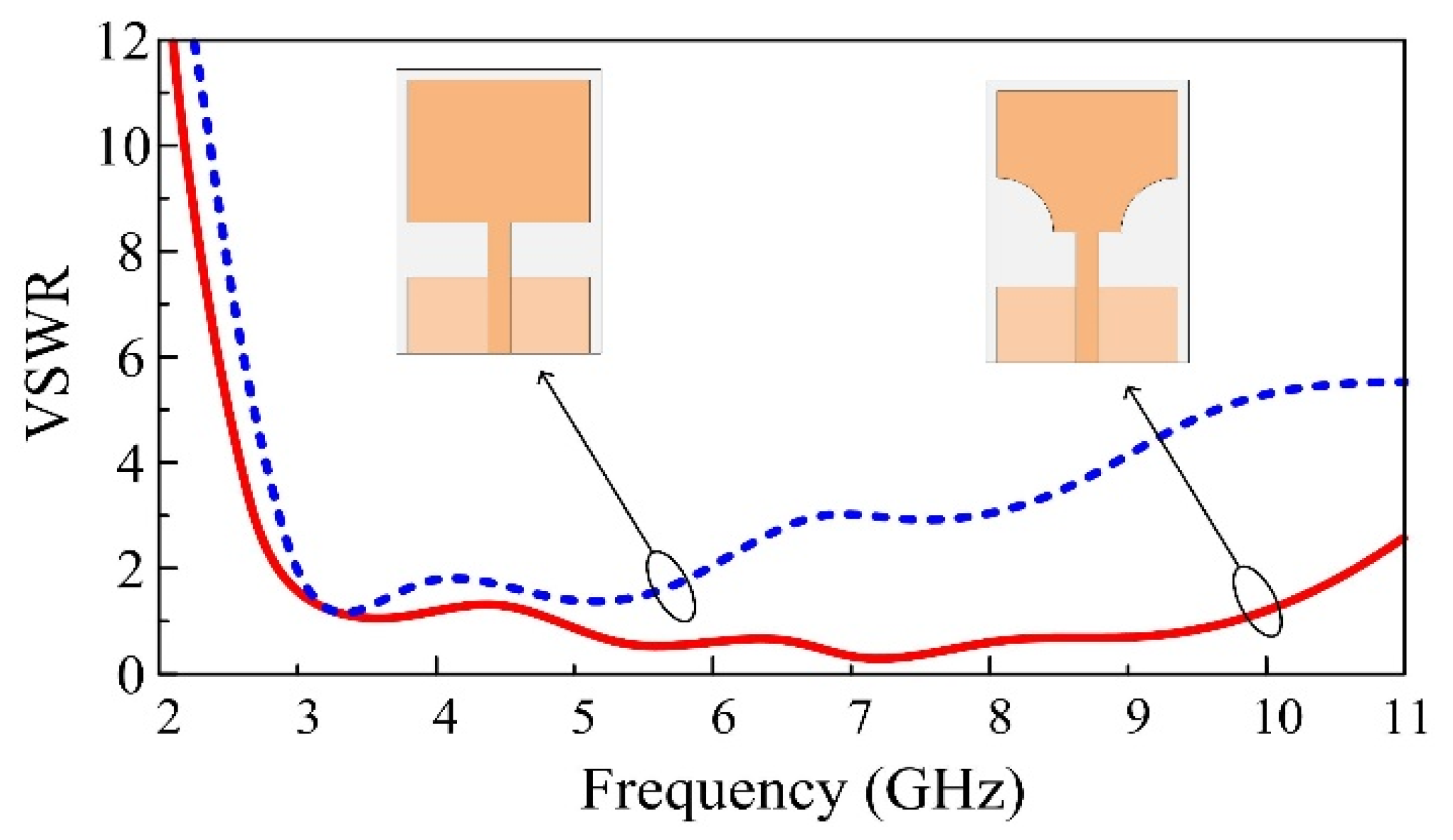
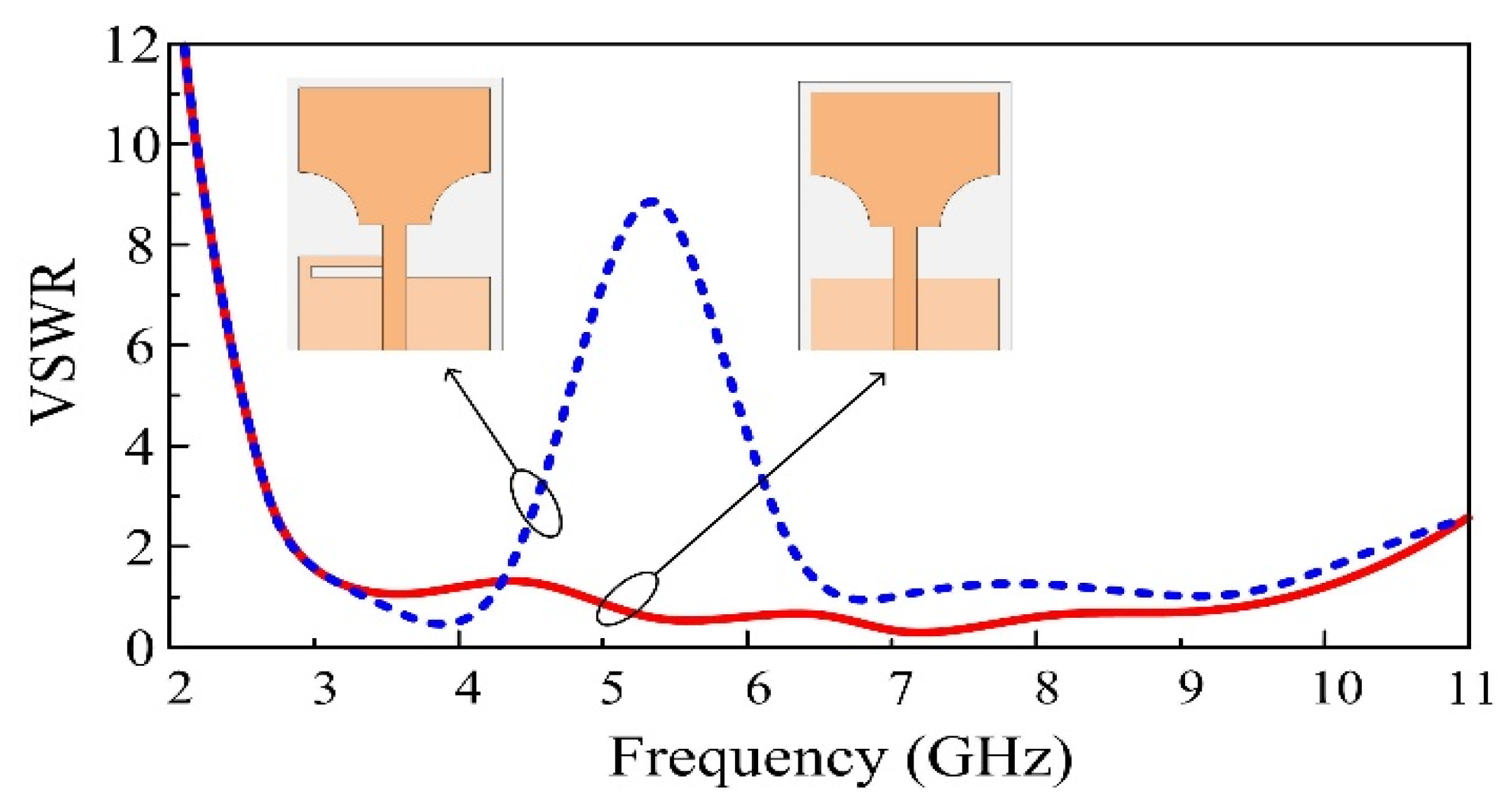
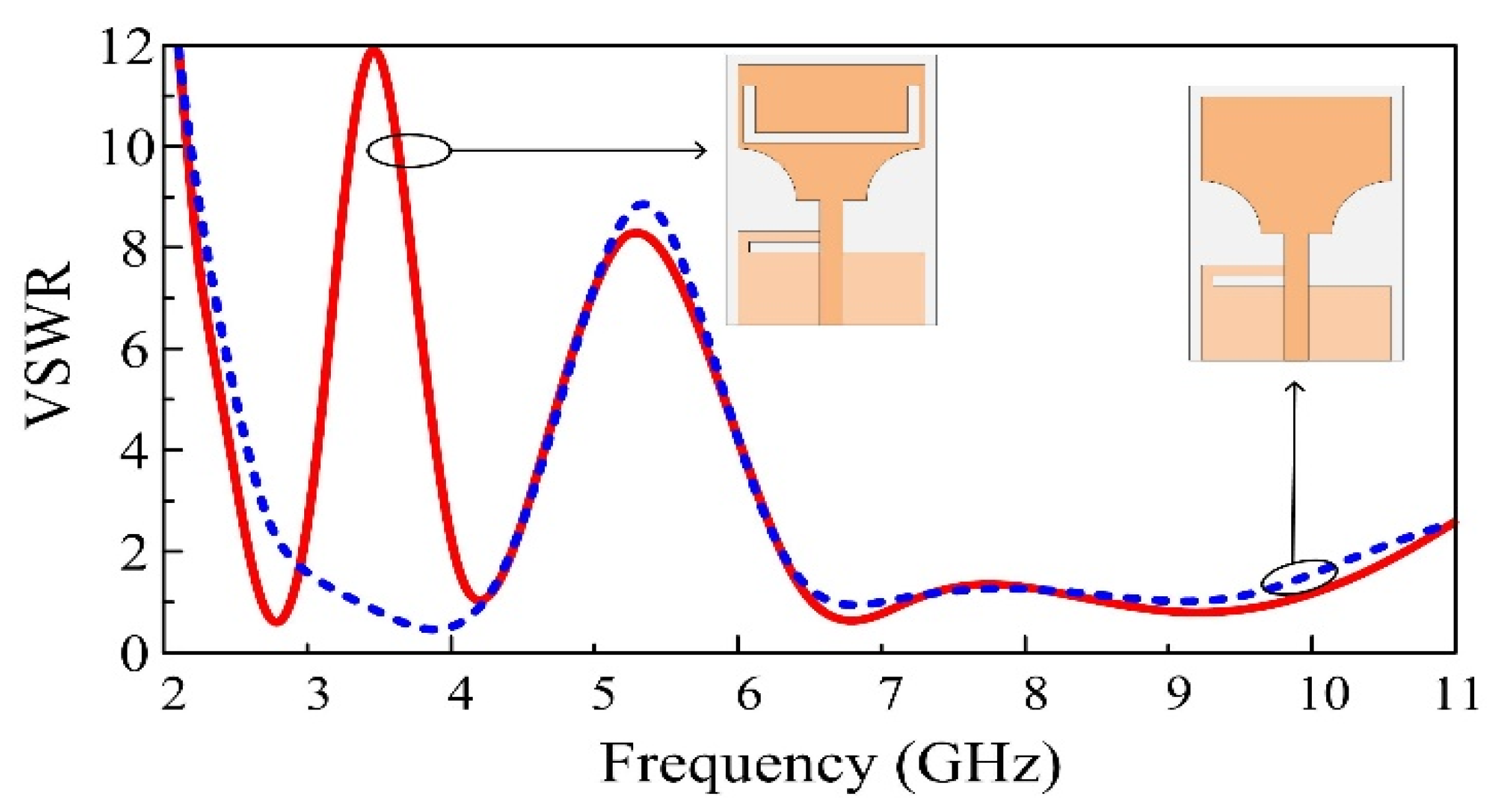

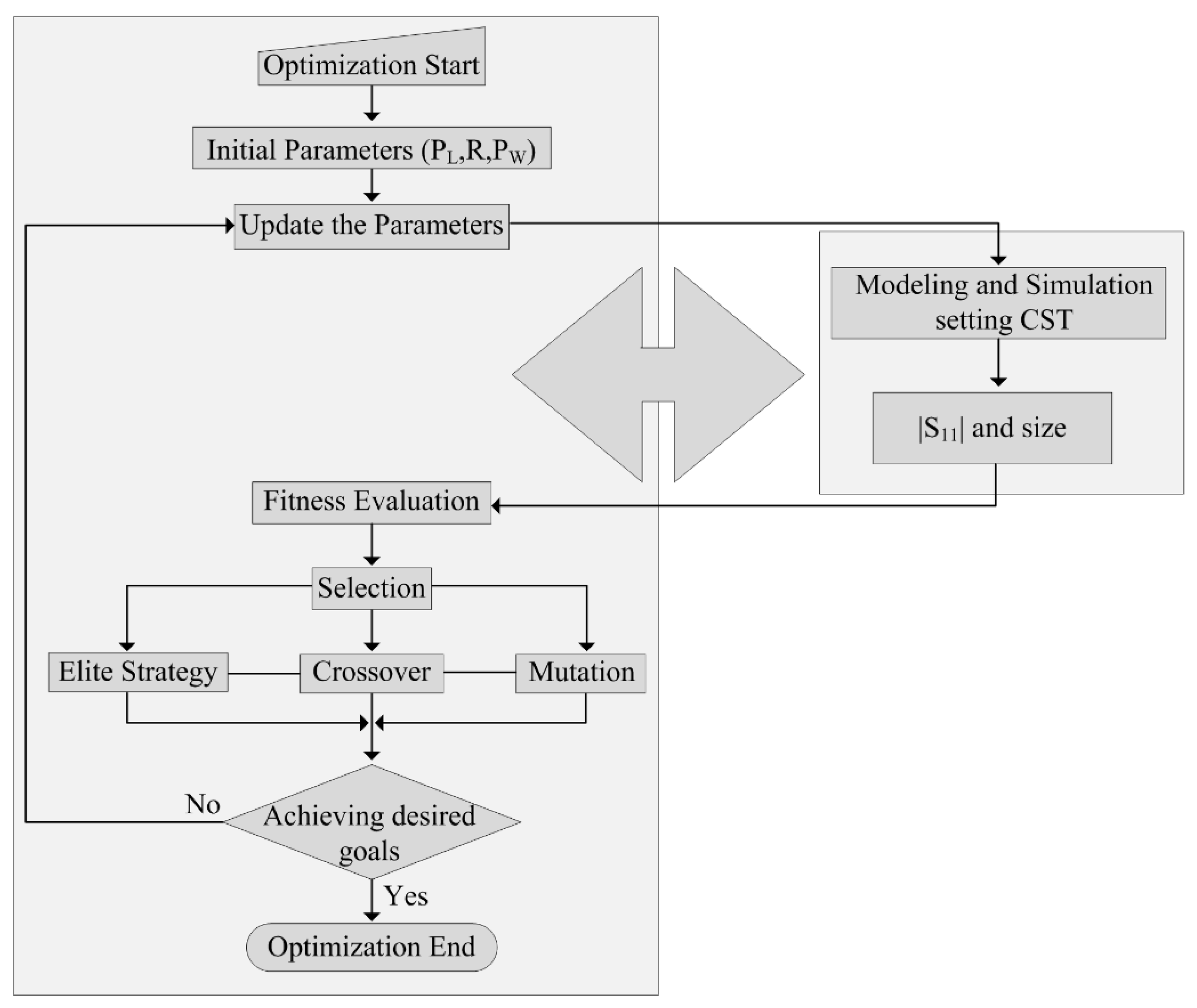
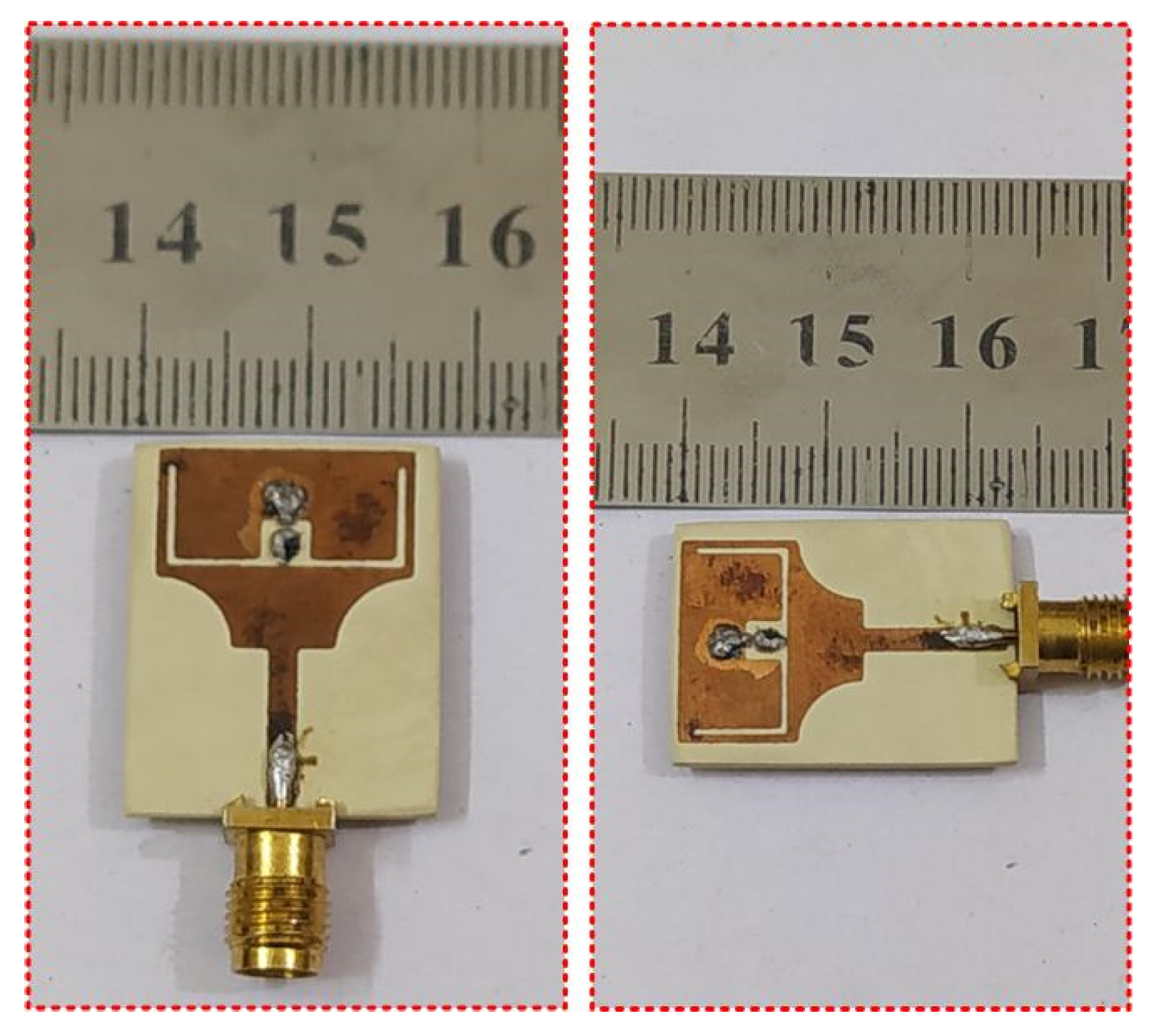
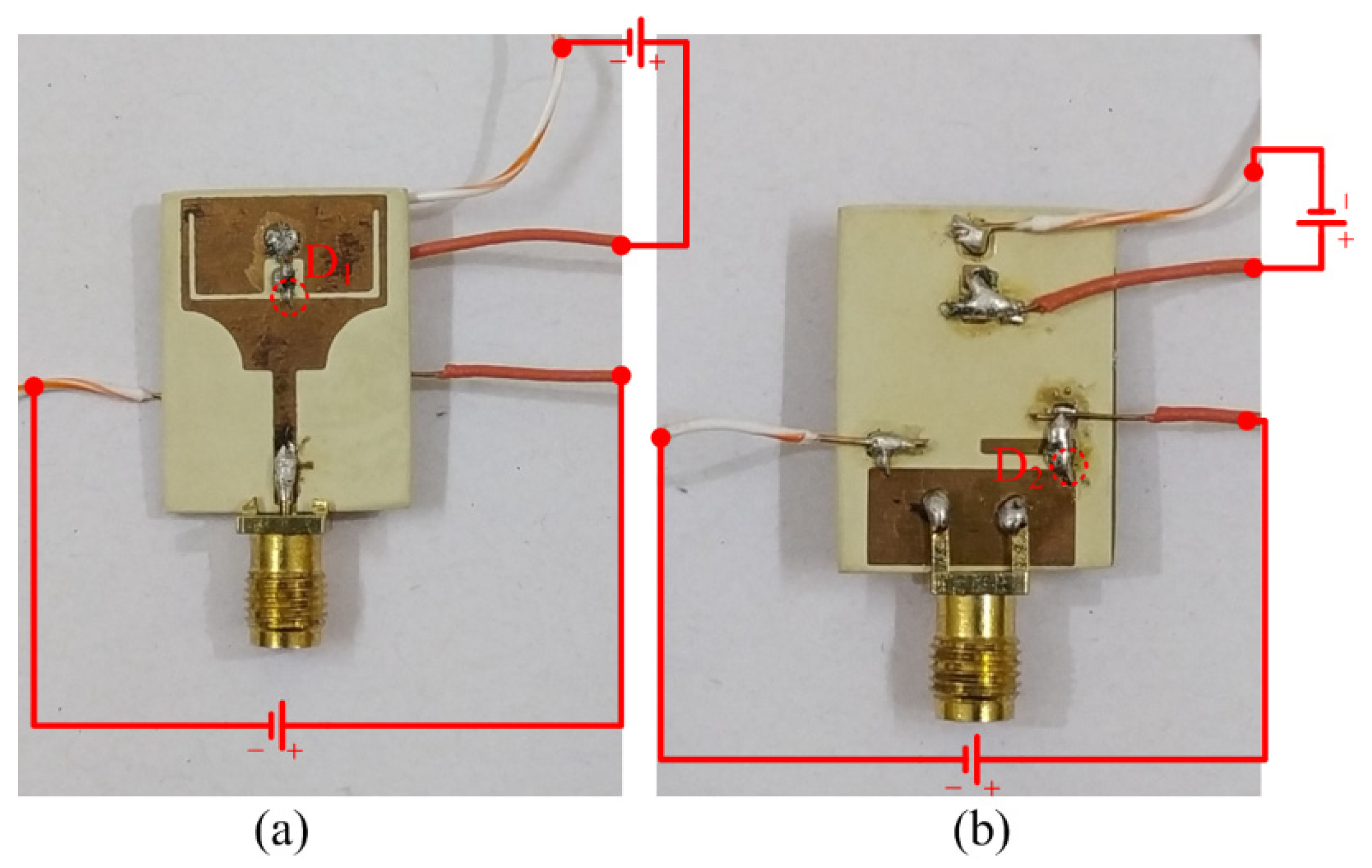
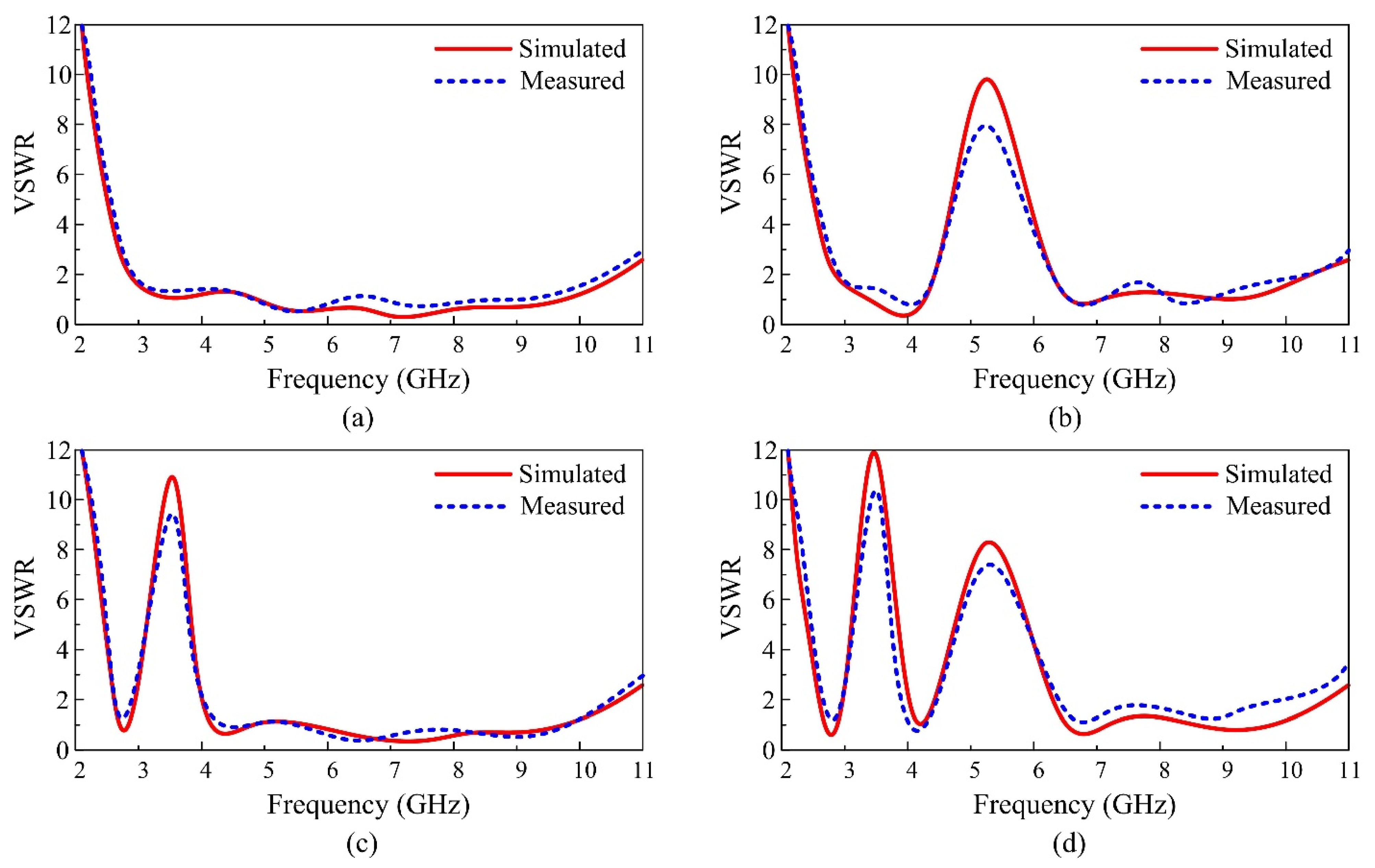
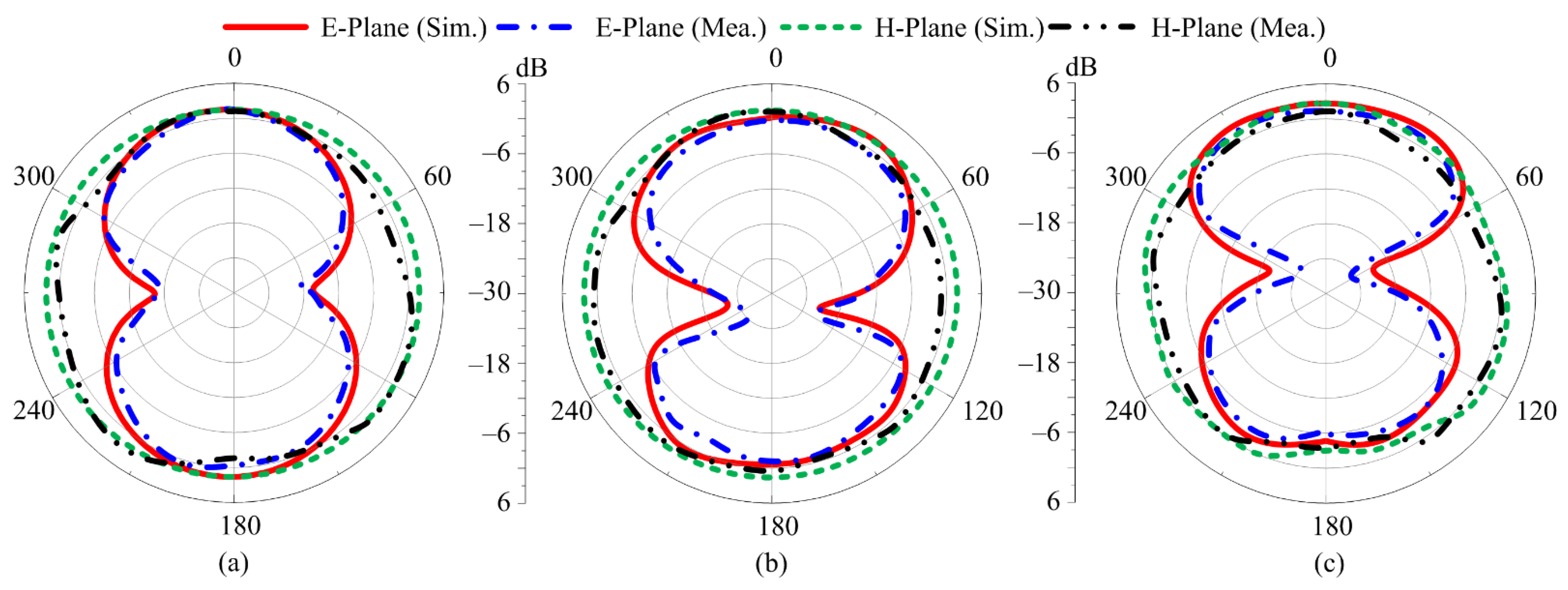

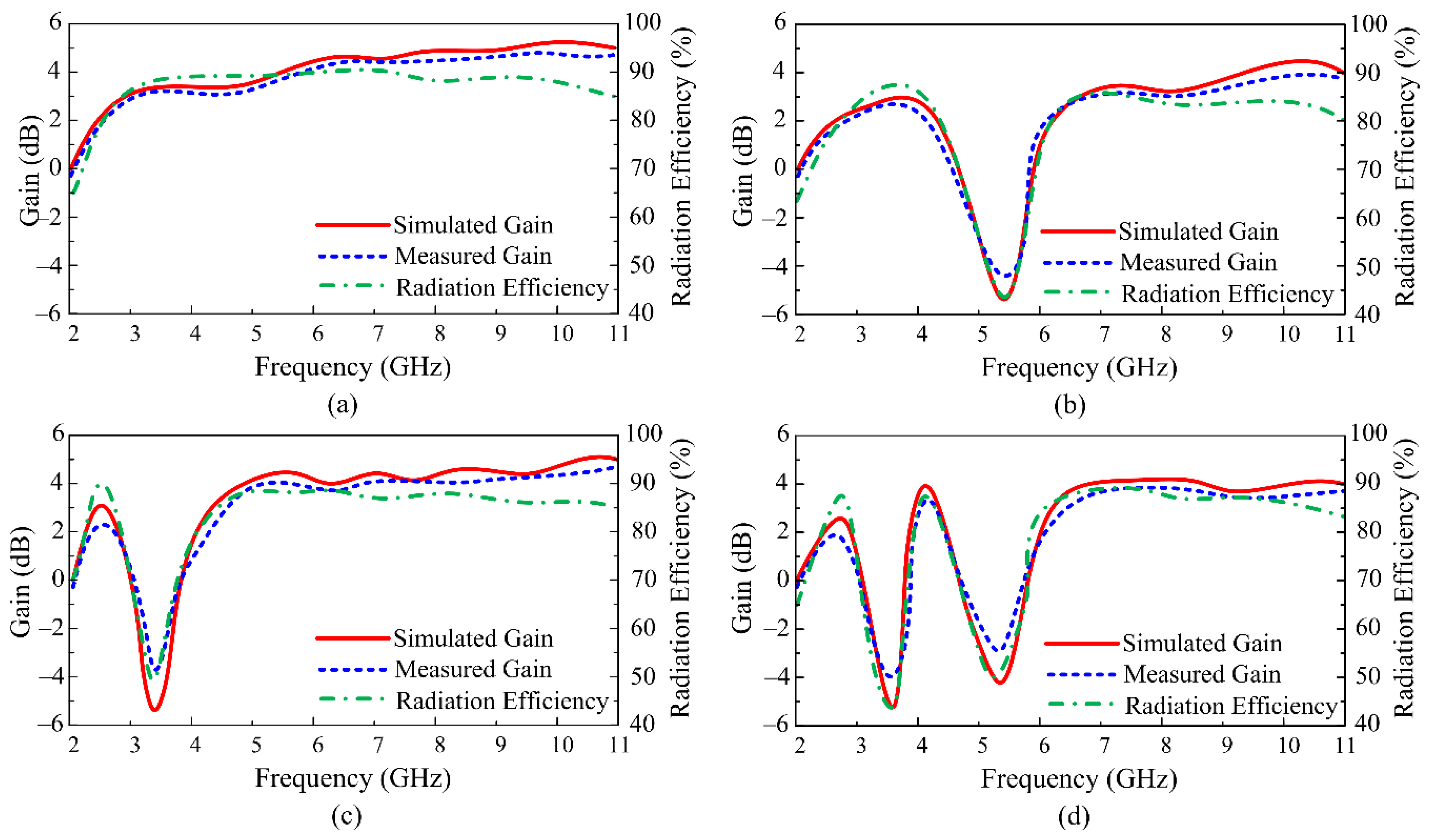
| Ref. No. | Dimension (mm × mm) | Bandwidth (GHz) | Notch Band (GHz) | Reconfigurability Method | Operational Modes |
|---|---|---|---|---|---|
| [13] | 39.8 × 23 | 1.8–12 | 4.8–6.2 | PIN diode | UWB UWB with a single notch |
| [14] | 42 × 32 | 2.2–12.5 | 3.1–4.5 | PIN diode | UWB with a single notch |
| 3.6–8.2 | |||||
| [15] | 36 × 34 | 2.8–10.3 | 1.8–4.35 | Varactor | UWB with two fixed and a single reconfigurable notch |
| [16] | 32 × 24 | 2.7–12 | 4.4–5 | Copper tape | UWB UWB with a single notch UWB with a dual notch |
| 7.7–9.2 | |||||
| [17] | 22 × 21 | 2.8–10.3 | 5.2–5.8 | Copper tape | UWB UWB with a single notch UWB with a dual notch |
| 7.8–9 | |||||
| [18] | 25 × 21 | 3.1–10 | 3.2–4 | PIN diodes | UWB with a single notch UWB with a dual notch UWB with a tri notch |
| 5.2–5.9 | |||||
| 7.9–9 | |||||
| Proposed work | 17 × 23 | 2.8–10.6 | 3–4.1 | PIN diodes | UWB UWB with a single notch UWB with a dual notch |
| 4.5–6.5 |
Publisher’s Note: MDPI stays neutral with regard to jurisdictional claims in published maps and institutional affiliations. |
© 2022 by the authors. Licensee MDPI, Basel, Switzerland. This article is an open access article distributed under the terms and conditions of the Creative Commons Attribution (CC BY) license (https://creativecommons.org/licenses/by/4.0/).
Share and Cite
Zaidi, A.; Awan, W.A.; Ghaffar, A.; Alzaidi, M.S.; Alsharef, M.; Elkamchouchi, D.H.; Ghoneim, S.S.M.; Alharbi, T.E.A. A Low Profile Ultra-Wideband Antenna with Reconfigurable Notch Band Characteristics for Smart Electronic Systems. Micromachines 2022, 13, 1803. https://doi.org/10.3390/mi13111803
Zaidi A, Awan WA, Ghaffar A, Alzaidi MS, Alsharef M, Elkamchouchi DH, Ghoneim SSM, Alharbi TEA. A Low Profile Ultra-Wideband Antenna with Reconfigurable Notch Band Characteristics for Smart Electronic Systems. Micromachines. 2022; 13(11):1803. https://doi.org/10.3390/mi13111803
Chicago/Turabian StyleZaidi, Abir, Wahaj Abbas Awan, Adnan Ghaffar, Mohammed S. Alzaidi, Mohammad Alsharef, Dalia H. Elkamchouchi, Sherif S. M. Ghoneim, and Turki E. A. Alharbi. 2022. "A Low Profile Ultra-Wideband Antenna with Reconfigurable Notch Band Characteristics for Smart Electronic Systems" Micromachines 13, no. 11: 1803. https://doi.org/10.3390/mi13111803
APA StyleZaidi, A., Awan, W. A., Ghaffar, A., Alzaidi, M. S., Alsharef, M., Elkamchouchi, D. H., Ghoneim, S. S. M., & Alharbi, T. E. A. (2022). A Low Profile Ultra-Wideband Antenna with Reconfigurable Notch Band Characteristics for Smart Electronic Systems. Micromachines, 13(11), 1803. https://doi.org/10.3390/mi13111803









